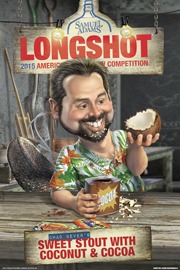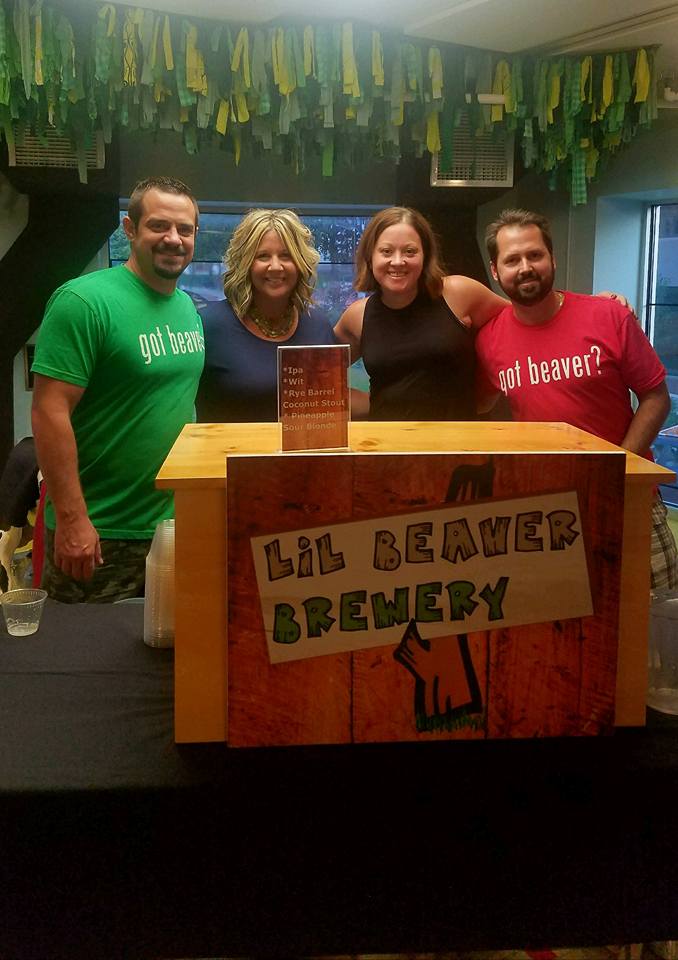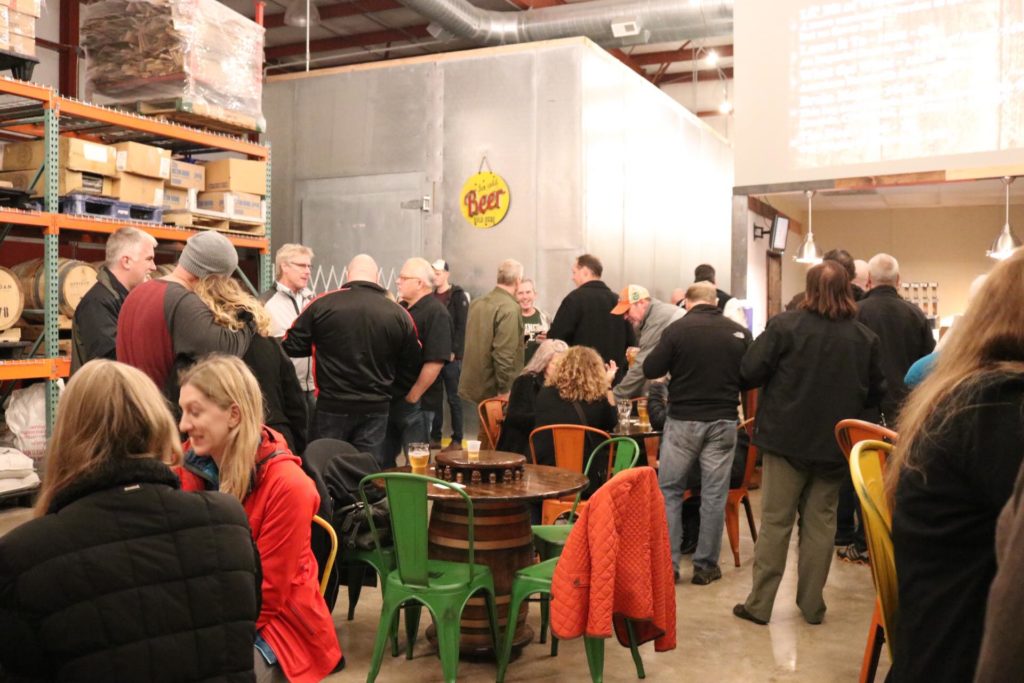A GDB favorite of 2016 goes from homebrew to commercial
 It was a homebrew competition that Chad Bevers admits he had largely forgotten about. Sure, he had submitted a chocolate coconut stout in the Samuel Adams LongShot American Homebrew Competition, but he wasn’t quite prepared – or even in town – when he got the email saying he had advanced to the next level and they needed more samples ASAP.
It was a homebrew competition that Chad Bevers admits he had largely forgotten about. Sure, he had submitted a chocolate coconut stout in the Samuel Adams LongShot American Homebrew Competition, but he wasn’t quite prepared – or even in town – when he got the email saying he had advanced to the next level and they needed more samples ASAP.
He got those samples shipped – maybe a couple days late – but was still shocked when he later got an email saying he was a finalist. That meant an all-expense- paid trip for him and his wife, Amy, to attend the 2015 Great American Beer Festival in Denver, where one of the finalists would have their beer bottled and distributed nationally.
That winner was not Bevers.
“But I already had people saying they couldn’t wait to buy my beer at the store,” he recalled. “That’s when I thought – well then, maybe I need to open my own brewery, so people can actually buy my beer. Then I had local places saying if I did it, they’d buy it. Then others asked if I needed money to do it and all of a sudden it was like – ‘holy crap, I can do this!’”
Last month, Lil’ Beaver Brewery opened its doors in downstate Bloomington. As Guys Drinking Beer listed in our favorite beers of 2016, one of Bevers’ homebrews made that short list. I sampled his Liquid Mounds Bar – a 13% imperial version of that LongShot finalist – at an event at Hammond’s 18th Street Brewery and it tasted exactly as billed, complete with coconut flakes visible in the glass. “Mindblowing,” we called it.
With his friend/now-business partner Dale Thomas, the lifelong Bloomington resident – whose regular job is working at a local food bank – recently purchased a 3,600 square-foot building, where they’re at a pace to produce about 700 barrels this year – with plenty of room to grow. Of course, that’s between day jobs, as “this is still a moonlighting gig for everyone right now.”
…Sure, right now…
We recently talked to Bevers about his leap from homebrewer to microbrewer, and tomorrow we’ll dig into why he walked away from using a sophomoric play on his last name that he initially used to market his beers.
You can sample his beers yourself at Forbidden Root’s anniversary party on March 8, as well as at Goose Island Stout Fest in April.
So what first got you into craft beer?
I got into brewing 17 years ago. Before that, I pretty much just drank Miller Lite. But I remember grabbing a 12-pack of J.W. Dundee’s Honey Brown, even though my friends thought I was crazy for trying something different. One night, while out to dinner, I decided to try something crazy – a Guinness. And I loved it. Then I stopped by a brewpub in Bloomington [the now-closed Illinois Brewing Company] and tried their 9% Porter From Hell. I loved it. It really opened my eyes. A few weeks later, I took my friend/now wife there and asked for it, but was told they sold out the night before.
I told the guy next to me how it had changed my whole outlook on beer. That turned out to be their head brewer [Tim], who showed me around. That’s when I decided to buy a homebrew kit and start making my own. About a month ago, I saw Tim and asked if he remembered me. He did. I told him I need his Porter From Hell recipe so I can brew it. He said he will. It that happens, man, that’s really bringing it all back together.
Was there a lot of trial-and- error when you started homebrewing?
I went gung-ho. I started extract brewing on a stovetop, then upgraded to all-grain, then didn’t mess with it for a while. We moved and then, a year later, I found my stuff and that’s when I really jumped in with both feet, decided to build a 10-tap kegerator, upgrade my equipment and went to town. That was 15 years ago. Five years ago, everything just clicked. It went from “this is fun” to “holy cow, I can make really good beer.”
So when did you start thinking – maybe I could do something with this?
I thought my stuff was good, but I knew I was a little biased. Then other people started saying it and probably five years ago, I was trading beers and decided to throw in a few homebrews. That’s when these guys started posting in forums about it and specifically asking me for my homebrews. “Send me your homebrew and I’ll get you anything you want!” All of a sudden, I’m trading homebrews for whales. I thought – “Woah! Maybe I’m onto something.”

How long is it between that thought and actually taking the leap?
In 2015, I entered two beers in the American Homebrewers Association National Homebrew Competition. My spice beer won gold in our region, then silver in the national competition. I called it “Fauxbraxas,” so you can imagine what it tasted like. Around the same time, I submitted my first chocolate coconut milk stout and entered that in the Sam Adams LongShot Competition. My wife had joked about me opening my own brewery for years, but I know it takes a lot and I didn’t want to ask that of her. After GABF, she said – you make very good beer, people love it, you need to do this. I reached out to [Thomas] and we started our planning. We launched a Kickstarter partially to gauge interest, partially to raise money. I was blown away by the response.
It had to be a great feeling when you opened those doors for the first time.
Probably the most surreal day was Dec. 30, when I walked out of the City Clerk’s office and had both our occupancy permit and our local liquor license. It was like – “holy cow, I can’t believe this! It’s real! We have our license!”
Have you encountered unexpected things since then?
The beer that we’re selling the most of is not at all what I expected. Our cream ale with vanilla beans – a very light flavor, very light alcohol beer – is our most popular. Aside from that, it’s our IPA. And I was into IPAs 10 years ago, brewing the hoppiest stuff I could find, but I burned out on it and started drinking stouts year-round. But I knew if I decided to open, I had to make IPAs. But me personally, I can’t brew a style that I can’t enjoy. So I sort of forced myself to drink IPAs again. Knowing the market and how popular they are, I knew I had to do it and got into them again.
It’s been a month now. What are the crowds like? How’s the scene?
We have a really supportive community here. But I will say the crowd coming into our taproom is not the crowd I expected to see. That’s not a bad thing, though. I just pictured your typical 20-30- year-olds coming in, looking for the latest and greatest. But people look around and say “I can’t believe I’m not the oldest one here.” We also have a lot of repeat customers, we’ve already seen some 8, 10 times. And it’s the variety that is keeping them coming back.
We have 10 beers on tap, but a unique brew system that allows us to brew 2-barrel batches, two at a time. We have 10 fermenters. So we do a lot of 2-barrel batches and can do 5 barrels at a time if we’re brewing the same thing – it just gives us a lot of flexibility. My goal is that if people come once a week, they’re going to see one or two different beers.
In Bloomington, we’ve got Destihl – they opened a $14 million mega-brewery a year ago, and a lot of people say: aren’t you worried about them? I tell them: nope, that’s the best thing that can happen for us. That’s going to draw people to the community. And if they come for that brewery, they’ll look to see what else is there.
So where do you see Lil’ Beaver in 3 to 5 years?
Honestly, I wish I could answer that. Going into our first weekend, we set what we thought would be realistic monthly goals. After that weekend, we realized we looked at it all wrong. It’s exceeded our expectations. Ask me in a year. Because we’ve been blown away by what we’ve seen so far. And I keep thinking: “well, maybe it’s a fluke.”
But then the next weekend is better than the last weekend. And the next weekend is better than that weekend. Now, we’ve had three or four places contacting us saying: “hey, we’re hearing great things about you guys. How can we get your beer in-house?” It’s definitely a good problem to have.
Next: What’s in a name? Chad Bevers admits he relied on some pretty sophomoric plays on his last name for the first few names of his beers. But then, he realized, his beer was better than that.
